Hubs for Circularity: Geo-Based Industrial Clustering towards Urban Symbiosis in Europe
Abstract
:1. Introduction
1.1. Circular Economy and the Relevance of European Cities and Industry
1.2. Cluster Analysis for Identification of Hubs
2. Methodology
2.1. Goal
2.2. Database
2.3. Clustering Methods
2.4. Comparison and Validation
2.5. Hubs for Circularity Indicators
3. Results
3.1. Database
3.2. Clustering Methods
- K-means
- HAC
- DBSCAN
3.3. H4C Indicators
- Clustering overview (size, countries and sectors)
- Urban clusters
- Carbon dioxide emissions
- Potential synergies
4. Discussion
4.1. Benchmark of Results
4.2. Implementing Hubs
4.3. Circularity Frameworks
5. Conclusions
Supplementary Materials
Author Contributions
Funding
Institutional Review Board Statement
Informed Consent Statement
Data Availability Statement
Acknowledgments
Conflicts of Interest
References
- IPCC. Global Warming of 1.5 °C. An IPCC Special Report on the Impacts of Global Warming of 1.5 °C above Pre-Industrial Levels and Related Global Greenhouse Gas Emission Pathways, in the Context of Strengthening the Global Response to the Threat of Climate Change, Sustainable Development, and Efforts to Eradicate Poverty. IPCC, 2018. Available online: https://www.ipcc.ch/sr15/download/#full (accessed on 12 November 2021).
- European Commission. The European Green Deal. European Commission, Brussels, Communication from the Commission to the European Parliament and the Council. COM(2019) 640 final, November 2019. Available online: https://ec.europa.eu/info/sites/info/files/european-green-deal-communication_en.pdf (accessed on 29 July 2020).
- European Commission. Communication from the Commission to the European Parliament, the Council, the European Economic and Social Committee and the Committee of the Regions: A New Circular Economy Action Plan for a Cleaner and More Competitive Europe; European Commission: Brussels, Belgium, 2020; Available online: https://eur-lex.europa.eu/resource.html?uri=cellar:9903b325-6388-11ea-b735-01aa75ed71a1.0017.02/DOC_1&format=PDF (accessed on 12 November 2021).
- A.SPIRE aisbl. European Partnership under Horizon Europe: Processes4Planet; Proposal Draft; European Commission: Brussels, Belgium, 2020; Available online: https://ec.europa.eu/info/sites/default/files/research_and_innovation/funding/documents/ec_rtd_he-partnerships-industry-for-sustainable-society.pdf (accessed on 24 August 2021).
- A.SPIRE. SPIRE 2050 Hubs for Circularity (H4C). EIT RawMaterials CIRCUIT Workshop. Available online: https://cdn2.hubspot.net/hubfs/2834550/5%202019%20SPIRE%202050%20H4C.pdf (accessed on 10 October 2019).
- Accenture, W. Industrial Clusters: Working Together to Achieve Net Zero. 2021. Available online: https://www.accenture.com/_acnmedia/PDF-147/Accenture-WEF-Industrial-Clusters.pdf (accessed on 31 August 2021).
- Lombardi, D.R.; Laybourn, P. Redefining Industrial Symbiosis. J. Ind. Ecol. 2012, 16, 28–37. [Google Scholar] [CrossRef]
- Wang, Y.; Xie, Y.; Qi, L.; He, Y.; Bo, H. Synergies evaluation and influencing factors analysis of the water–energy–food nexus from symbiosis perspective: A case study in the Beijing–Tianjin–Hebei region. Sci. Total Environ. 2021, 151731. [Google Scholar] [CrossRef]
- Cervo, H. Development of a Methodology Enabling the Identification of Industrial Symbiosis Opportunities and Their Assessment in the Petrochemical Industry. Ph.D. Thesis, Faculteit Ingenieurswetenschappen en Architectuur, Universiteit Gent, Ghent, Belgium, 2020. [Google Scholar]
- Gallaud, D.; Laperche, B. Circular Economy, Industrial Ecology and Short Supply Chain; John Wiley & Sons: Hoboken, NJ, USA, 2016; Available online: https://www.wiley.com/en-us/Circular+Economy%2C+Industrial+Ecology+and+Short+Supply+Chain-p-9781119307471 (accessed on 28 December 2020).
- Van Eetvelde, G. Industrial Symbiosis. In Resource Efficiency of Processing Plants: Monitoring and Improvement; Krämer, S., Engell, S., Eds.; Wiley-VCH Verlag GmbH & Co: Weinheim, Germany, 2018; pp. 441–469. [Google Scholar]
- Connett, P. The Zero Waste Solution; Chelsea Green Publishing: London, UK, 2013. [Google Scholar]
- Friedmann, D.S.J.; Agrawal, M.; Bhardwaj, A. Evaluating Net-Zero Industrial Hubs in the United States: A Case Study of Houston; Center on Global Energy Policy at Columbia University SIPA: New York, NY, USA; p. 32. Available online: https://www.energypolicy.columbia.edu/sites/default/files/file-uploads/Houston,%20final%20design,%206.29.21.pdf (accessed on 5 November 2021).
- Lansink, A. Challenging Changes—Connecting Waste Hierarchy and Circular Economy, 1st ed.; LEA Nijmegen: Nijmegen, The Netherlands, 2017. [Google Scholar] [CrossRef]
- Sun, L.; Fujii, M.; Li, Z.; Dong, H.; Geng, Y.; Liu, Z.; Fujita, T.; Yu, X.; Zhang, Y. Energy-saving and carbon emission reduction effect of urban-industrial symbiosis implementation with feasibility analysis in the city. Technol. Forecast. Soc. Chang. 2020, 151, 119853. [Google Scholar] [CrossRef]
- Feiferytė-Skirienė, A.; Stasiškienė, Ž. Seeking Circularity: Circular Urban Metabolism in the Context of Industrial Symbiosis. Sustainability 2021, 13, 9094. [Google Scholar] [CrossRef]
- Lu, H. Chapter 12—Madrid, Spain. In Eco-Cities and Green Transport; Elsevier: Amsterdam, The Netherlands, 2020; pp. 249–263. [Google Scholar]
- Masi, D.; Day, S.; Godsell, J. Supply Chain Configurations in the Circular Economy: A Systematic Literature Review. Sustainability 2017, 9, 1602. [Google Scholar] [CrossRef] [Green Version]
- Fonseca, L.M.; Domingues, J.P.; Pereira, M.T.; Martins, F.F.; Zimon, D. Assessment of Circular Economy within Portuguese Organizations. Sustainability 2018, 10, 2521. [Google Scholar] [CrossRef] [Green Version]
- Ranjbari, M.; Saidani, M.; Esfandabadi, Z.S.; Peng, W.; Lam, S.S.; Aghbashlo, M.; Quatraro, F.; Tabatabaei, M. Two decades of research on waste management in the circular economy: Insights from bibliometric, text mining, and content analyses. J. Clean. Prod. 2021, 314, 128009. [Google Scholar] [CrossRef]
- EMF. Growth within: A Circular Economy Vision for a Competitive Europe. Ellen MacArthur Foundation, 2015. Available online: https://www.ellenmacarthurfoundation.org/assets/downloads/publications/EllenMacArthurFoundation_Growth-Within_July15.pdf (accessed on 28 January 2020).
- European Commission. Critical Raw Materials. In Internal Market, Industry, Entrepreneurship and SMEs; European Commission: Brussels, Belgium, 2016; Available online: https://ec.europa.eu/growth/sectors/raw-materials/specific-interest/critical_en (accessed on 24 August 2021).
- Sarja, M.; Onkila, T.; Mäkelä, M. A systematic literature review of the transition to the circular economy in business organizations: Obstacles, catalysts and ambivalences. J. Clean. Prod. 2021, 286, 125492. [Google Scholar] [CrossRef]
- Material Economics. Industrial Transformation 2050 Pathways to Net-Zero Emissions from EU Heavy Industry; University of Cambridge Institute for Sustainability Leadership: Cambridge, UK, 2019. [Google Scholar]
- Kusch, S. Industrial Symbiosis: Powerful Mechanisms for Sustainable Use of Environmental Resources. 2015. Available online: https://sustainabledevelopment.un.org/content/documents/635486-Kusch-Industrial%20symbiosis_powerful%20mechanisms%20for%20sustainable%20use%20of%20environmental%20resources.pdf (accessed on 5 November 2021).
- United Nations Environment Programme. The Weight of Cities. Resource Requirements of Future Urbanization. 2018. Available online: https://www.resourcepanel.org/reports/weight-cities (accessed on 31 August 2021).
- United Nations. World Population Prospects—Population Division—United Nations. 2019. Available online: https://population.un.org/wpp/ (accessed on 31 August 2021).
- Baynes, T.M.; Musango, J.K. Estimating current and future global urban domestic material consumption. Environ. Res. Lett. 2018, 13, 065012. [Google Scholar] [CrossRef]
- Joint Research Centre (European Commission). The Future of Cities: Opportunities, Challanges and the Way Forward; EC Publications Office: Luxembourg, 2019; Available online: https://data.europa.eu/doi/10.2760/375209 (accessed on 9 May 2021).
- HLGEEIs. Masterplan for a Competitive Transformation of EU Energy-Intensive Industries Enabling a Climate-Neutral, Circular Economy by 2050; Publications Office of the European Union: Luxembourg, 2019; Available online: http://op.europa.eu/en/publication-detail/-/publication/be308ba7-14da-11ea-8c1f-01aa75ed71a1/language-en (accessed on 6 July 2020).
- CEFIC. Landscape of the European Chemical Industry 2020; European Chemical Industry Council: Brussels, Belgium, 2020; Available online: https://www.chemlandscape.cefic.org/wp-content/uploads/combined/fullDoc.pdf (accessed on 14 July 2020).
- Elser, B.; Ulbrich, M. Taking the European Chemical Industry into the Circular Economy; Accenture: Brussels, Belgium, 2017; Available online: accenture-cefic-report-exec-summary.pdf (accessed on 5 November 2020).
- de Bruyn, S.; Jongsma, C.; Kampman, B.; Görlach, B.; Thie, J.-E. Energy-Intensive Industries—Challenges and Opportunities in Energy Transition; European Parliament: Luxembourg, 2020. [Google Scholar]
- Ketels, C.H.M. The Role of Clusters in the Chemical Industry. Report (Prepared for the Annual Conference of the European Petrochemical Association (EPCA)). 2007. Available online: https://www.hbs.edu/faculty/Pages/item.aspx?num=30557 (accessed on 5 November 2021).
- Lowe, E.A.; Evans, L.K. Industrial ecology and industrial ecosystems. J. Clean. Prod. 1995, 3, 47–53. [Google Scholar] [CrossRef]
- EUROFER. 2020 European Steel in Figures. European Steel Association, 2020. Available online: https://www.eurofer.eu/assets/Uploads/European-Steel-in-Figures-2020.pdf (accessed on 5 November 2021).
- European Commission. Energy Efficiency and CO2 Reduction in the Iron and Steel Industry; European Commission: Brussels, Belgium, 2014. [Google Scholar]
- CEMBUREAU. 2019 Activity Report; The European Cement Association: Brussels, Belgium, 2019; Available online: https://cembureau.eu/media/1967/activity-report-2019.pdf (accessed on 5 November 2021).
- Sinharay, S. An Overview of Statistics in Education. In International Encyclopedia of Education; Elsevier Ltd.: Amsterdam, The Netherlands, 2010; pp. 1–11. [Google Scholar] [CrossRef]
- Estivill-Castro, V. Why so many clustering algorithms: A position paper. ACM SIGKDD Explor. Newsl. 2002, 4, 65–75. [Google Scholar] [CrossRef]
- Berkhin, P. A Survey of Clustering Data Mining Techniques. In Grouping Multidimensional Data: Recent Advances in Clustering; Kogan, J., Nicholas, C., Teboulle, M., Eds.; Springer: Berlin/Heidelberg, Germany, 2006; pp. 25–71. [Google Scholar] [CrossRef]
- Superti, V.; Merino-Saum, A.; Baur, I.; Binder, C.R. Unraveling how the concept of circularity relates to sustainability: An indicator-based meta-analysis applied at the urban scale. J. Clean. Prod. 2021, 315, 128070. [Google Scholar] [CrossRef]
- Dunkelberg, H.; Schlosser, F.; Veitengruber, F.; Meschede, H.; Heidrich, T. Classification and clustering of the German plastic industry with a special focus on the implementation of low and high temperature waste heat. J. Clean. Prod. 2019, 238, 117784. [Google Scholar] [CrossRef]
- Arbolino, R.; Boffardi, R.; Lanuzza, F.; Ioppolo, G. Monitoring and evaluation of regional industrial sustainability: Evidence from Italian regions. Land Use Policy 2018, 75, 420–428. [Google Scholar] [CrossRef]
- EPOS Project. EPOS insight#17: Industrial Symbiosis Generic Cases and EU Impact Potential. 2019. Available online: https://www.spire2030.eu/sites/default/files/users/user222/Epos-docs/Insights/epos_-_insights_17.pdf (accessed on 12 January 2020).
- SCALER Project. SCALing European Resources—With Industrial Symbiosis. 2020. Available online: https://www.scalerproject.eu/ (accessed on 14 July 2020).
- INCUBIS Project. Incubator for Maximizing Waste Heat/Cold Efficiency in Industrial Parks and Districts. 2020. Available online: http://www.incub-is.eu/ (accessed on 31 August 2021).
- Rokach, L.; Maimon, O. Clustering Methods. In Data Mining and Knowledge Discovery Handbook; Maimon, O., Rokach, L., Eds.; Springer: Boston, MA, USA, 2005; pp. 321–352. [Google Scholar] [CrossRef]
- Schubert, E.; Sander, J.; Ester, M.; Kriegel, H.P.; Xu, X. DBSCAN Revisited, Revisited: Why and How You Should (Still) Use DBSCAN. ACM Trans. Database Syst. 2017, 42, 19:1–19:21. [Google Scholar] [CrossRef]
- European Commission. The European Pollutant Release and Transfer Register (E-PRTR)—Environment. 2020. Available online: https://ec.europa.eu/environment/industry/stationary/e-prtr/legislation.htm (accessed on 1 September 2020).
- European Commission. Eltis|The Urban Mobility Observatory. 2021. Available online: https://www.eltis.org/ (accessed on 1 September 2021).
- Datanovia. Assessing Clustering Tendency. Datanovia, 2021. Available online: https://www.datanovia.com/en/lessons/assessing-clustering-tendency/ (accessed on 8 September 2021).
- Lawson, R.G.; Jurs, P.C. New index for clustering tendency and its application to chemical problems. J. Chem. Inf. Comput. Sci. 1990, 30, 36–41. [Google Scholar] [CrossRef]
- Open Source Libs. Pyclustertend—A Python Package to Assess Cluster Tendency—(Pyclustertend). 2021. Available online: https://opensourcelibs.com/lib/pyclustertend (accessed on 9 November 2021).
- Datanovia. Determining The Optimal Number of Clusters: 3 Must Know Methods. 2021. Available online: https://www.datanovia.com/en/lessons/determining-the-optimal-number-of-clusters-3-must-know-methods/ (accessed on 8 September 2021).
- Ketchen, D.J.; Shook, C.L. The Application of Cluster Analysis in Strategic Management Research: An Analysis and Critique. Strateg. Manag. J. 1996, 17, 441–458. [Google Scholar] [CrossRef]
- sklearn.metrics.pairwise.haversine_distances. Scikit-Learn. Available online: https://scikit-learn.org/stable/modules/generated/sklearn.metrics.pairwise.haversine_distances.html (accessed on 17 November 2021).
- Scikit-Learn Developers. Scikit-Learn-Getting Started. Scikit-Learn, 2021. Available online: https://scikit-learn/stable/getting_started.html (accessed on 9 November 2021).
- VanderPlas, J. Chapter 5: Introducing Scikit-Learn. In Python Data Science Handbook: Essential Tools for Working with Data, 2nd ed.; O’Reilly Media, Inc.: Sebastopol, CA, USA, 2017; pp. 343–359. [Google Scholar]
- VanderPlas, J. Chapter 2:Introduction to NumPy. In Python Data Science Handbook: Essential Tools for Working with Data, 2nd ed.; O’Reilly Media, Inc.: Sebastopol, CA, USA, 2017; pp. 33–96. [Google Scholar]
- VanderPlas, J. Chapter 3: Data Manipulation with Pandas. In Python Data Science Handbook: Essential Tools for Working with Data, 2nd ed.; O’Reilly Media, Inc.: Sebastopol, CA, USA, 2017; pp. 97–215. [Google Scholar]
- Datanovia. Cluster Validation Statistics: Must Know Methods. Datanovia, 2021. Available online: https://www.datanovia.com/en/lessons/cluster-validation-statistics-must-know-methods/ (accessed on 8 September 2021).
- Brock, G.; Pihur, V.; Datta, S.; Datta, S. clValid: An R Package for Cluster Validation. J. Stat. Softw. 2008, 25, 1–18. [Google Scholar] [CrossRef] [Green Version]
- Charrad, M.; Ghazzali, N.; Boiteau, V.; Niknafs, A. NbClust: An R Package for Determining the Relevant Number of Clusters in a Data Set. J. Stat. Softw. 2014, 61. [Google Scholar] [CrossRef] [Green Version]
- Joint Research Centre (European Commission); Veneri, P.; Moreno-Monroy, A.; Maffenini, L.; Schiavina, M. GHSL-OECD Functional Urban Areas: Public Release of GHS FUA; Publications Office of the European Union: Luxembourg, 2019; Available online: https://data.europa.eu/doi/10.2760/67415 (accessed on 15 November 2021).
- Mendez-Alva, F.; Cervo, H.; Krese, G.; van Eetvelde, G. Industrial symbiosis profiles in energy-intensive industries: Sectoral insights from open databases. J. Clean. Prod. 2021, 314, 128031. [Google Scholar] [CrossRef]
- VanderPlas, J. Chapter 4: Visualization with Matplotlib. In Python Data Science Handbook: Essential Tools for Working with Data, 2nd ed.; O’Reilly Media, Inc.: Sebastopol, CA, USA, 2017; pp. 217–330. [Google Scholar]
- Rob Story. Folium—Folium 0.12.1 Documentation. 2013. Available online: https://python-visualization.github.io/folium/ (accessed on 9 November 2021).
- Qiu, B.; Cao, X. Clustering boundary detection for high dimensional space based on space inversion and Hopkins statistics. Knowl.-Based Syst. 2016, 98, 216–225. [Google Scholar] [CrossRef]
- Jensen, P.D.; Basson, L.; Hellawell, E.E.; Bailey, M.R.; Leach, M. Quantifying “geographic proximity”: Experiences from the United Kingdom’s National Industrial Symbiosis Programme. Resour. Conserv. Recycl. 2011, 55, 703–712. [Google Scholar] [CrossRef] [Green Version]
- UN-SD. United Nations Standard Country or Area Codes for Statistical Use (M49) Including Geographical Regions. 2021. Available online: https://unstats.un.org/unsd/methodology/m49/ (accessed on 9 December 2021).
- Chertow, M.R. “Uncovering” Industrial Symbiosis. J. Ind. Ecol. 2007, 11, 11–30. [Google Scholar] [CrossRef]
- Moulavi, D.; Jaskowiak, P.A.; Campello, R.J.G.B.; Zimek, A.; Sander, J. Density-Based Clustering Validation. In Proceedings of the 2014 SIAM International Conference on Data Mining, Philadelphia, PA, USA, 24–26 April 2014; pp. 839–847. [Google Scholar] [CrossRef] [Green Version]
- EPOS Project. Insight#1 IS Market Study. 2019. Available online: https://www.spire2030.eu/sites/default/files/users/user222/Epos-docs/epos%20insights%201_v8.pdf (accessed on 25 September 2021).
- SCALER Project and Symbiosis in Europe. Quantified Potential of Industrial Symbiosis in Europe. Deliverable 3.5. Available online: https://www.scalerproject.eu/wp-content/uploads/2020/06/D3.5_SCALER_Quantified-potential-of-industrial-symbiosis-in-Europe_v1.0.pdf (accessed on 10 December 2021).
- Tanaka, K.; Managi, S. Industrial agglomeration effect for energy efficiency in Japanese production plants. Energy Policy 2021, 156, 112442. [Google Scholar] [CrossRef]
- European Commission. Waste Framework Directive. Categorisation System for the Circular Economy. 2008. Available online: https://ec.europa.eu/environment/topics/waste-and-recycling/waste-framework-directive_en (accessed on 27 September 2021).
- European Commission. Categorisation System for the Circular Economy. 2020. Available online: https://ec.europa.eu/info/publications/categorisation-system-circular-economy_en (accessed on 27 September 2021).
- United Nations. Mainstreaming the 3Rs and Resource Efficiency in the Overall Policy Development at Local and National Levels in Asia-Pacific Countries—United Nations Partnerships for SDGs Platform. 2013. Available online: https://sustainabledevelopment.un.org/partnership/?p=96 (accessed on 29 September 2021).
- Elsevier. Report: How Can Research Help the World Hit Net Zero by 2050? Elsevier Connect. Available online: https://www.elsevier.com/connect/net-zero-report (accessed on 15 November 2021).
- European Commission. Innovation Fund. Climate Action—European Commission. 12 February 2019. Available online: https://ec.europa.eu/clima/policies/innovation-fund_en (accessed on 27 September 2021).
- Directorate-General for Research and Innovation (European Commission); Sommer, K.H. Study and Portfolio Review of the Projects on Industrial Symbiosis in DG Research and Innovation: Findings and Recommendations; Publications Office of the European Union: Luxemburg, 2020; Available online: https://data.europa.eu/doi/10.2777/381211 (accessed on 29 September 2021).
- EPOS Project. Insight#11 Generic Industrial Symbiosis Validation Scheme. 2019. Available online: https://www.spire2030.eu/sites/default/files/users/user222/epos%20insights%2011.pdf (accessed on 5 November 2021).
- Henriques, J.D.; Azevedo, J.; Dias, R.; Estrela, M.; Ascenço, C.; Vladimirova, D.; Miller, K. Implementing Industrial Symbiosis Incentives: An Applied Assessment Framework for Risk Mitigation. Circ. Econ. Sustain. 2021, 1–24. [Google Scholar] [CrossRef]
- Barascu, A.; Castillo-Castillo, A.; Papaioannou, R.-F. Deliverable 7.2: Study Including Replication Potentials and Preferred Sites for Industrial Symbiosis (Carbon4PURE). Carbon4PUR Consortium, Project Deliverable/Public Report. March 2021. Available online: www.carbon4pur.eu (accessed on 5 November 2021).
- DECHEMA. D2.2: Report on Fully Integrated and Intensified Value Chain Concepts for Industrial Symbiosis. CarbonNext Project, Public Deliverable. November 2017. Available online: http://carbonnext.eu/Deliverables/_/D2.2%20Industrial%20symbiosis.pdf (accessed on 5 November 2021).
- Fonseca, L.; Amaral, A.; Oliveira, J. Quality 4.0: The EFQM 2020 Model and Industry 4.0 Relationships and Implications. Sustainability 2021, 13, 3107. [Google Scholar] [CrossRef]
- Belhadi, A.; Kamble, S.S.; Jabbour, C.J.C.; Mani, V.; Khan, S.A.R.; Touriki, F.E. A self-assessment tool for evaluating the integration of circular economy and industry 4.0 principles in closed-loop supply chains. Int. J. Prod. Econ. 2021, 108372. [Google Scholar] [CrossRef]
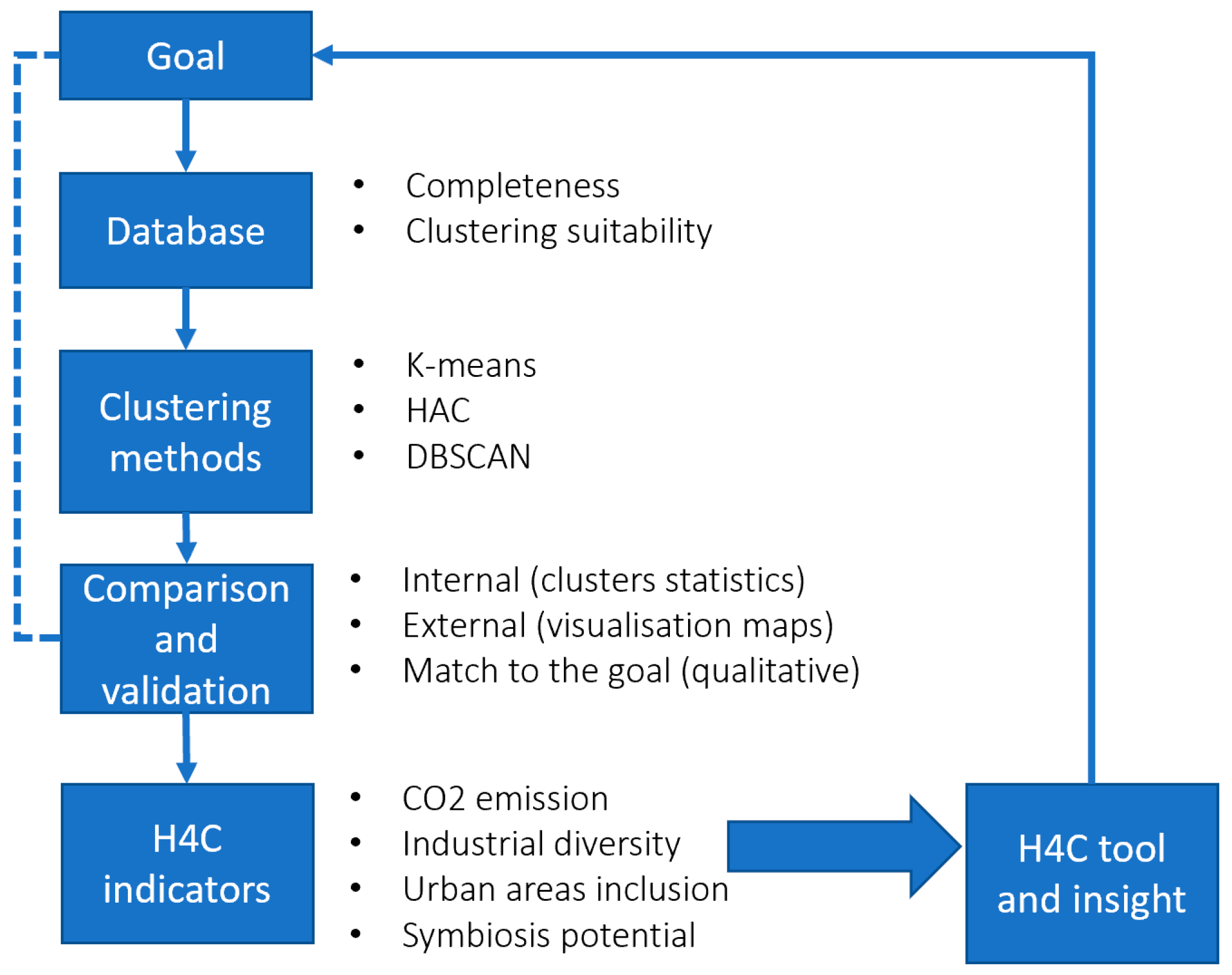


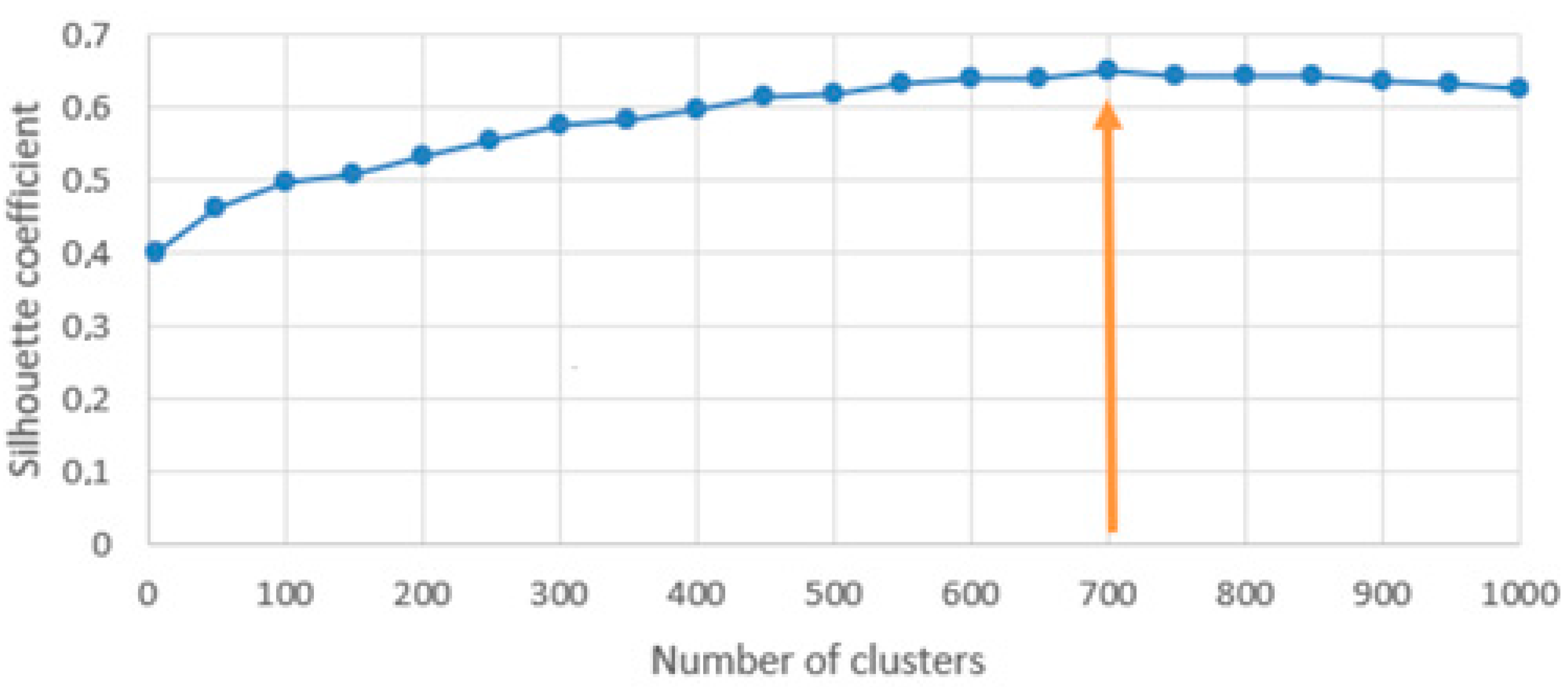
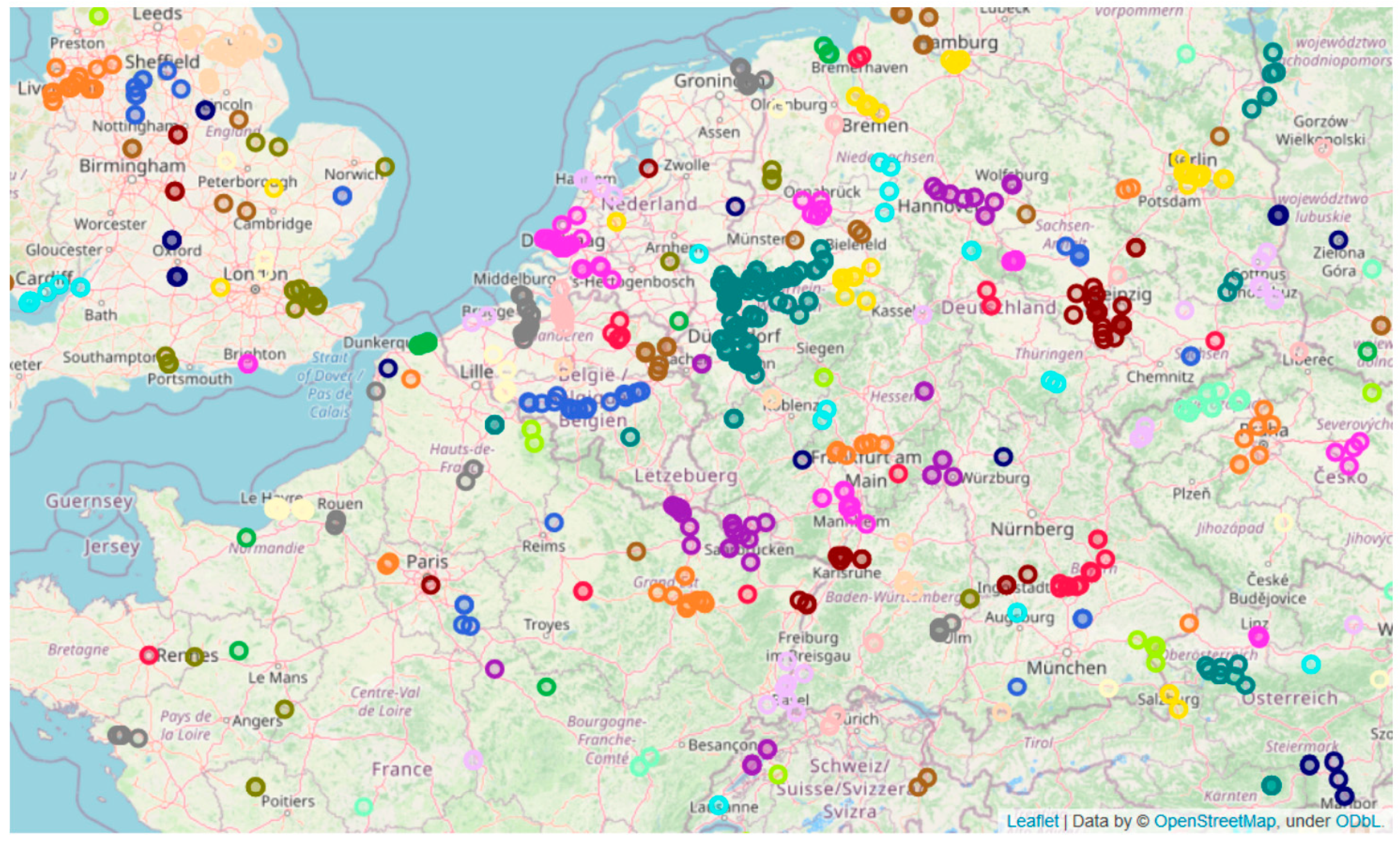

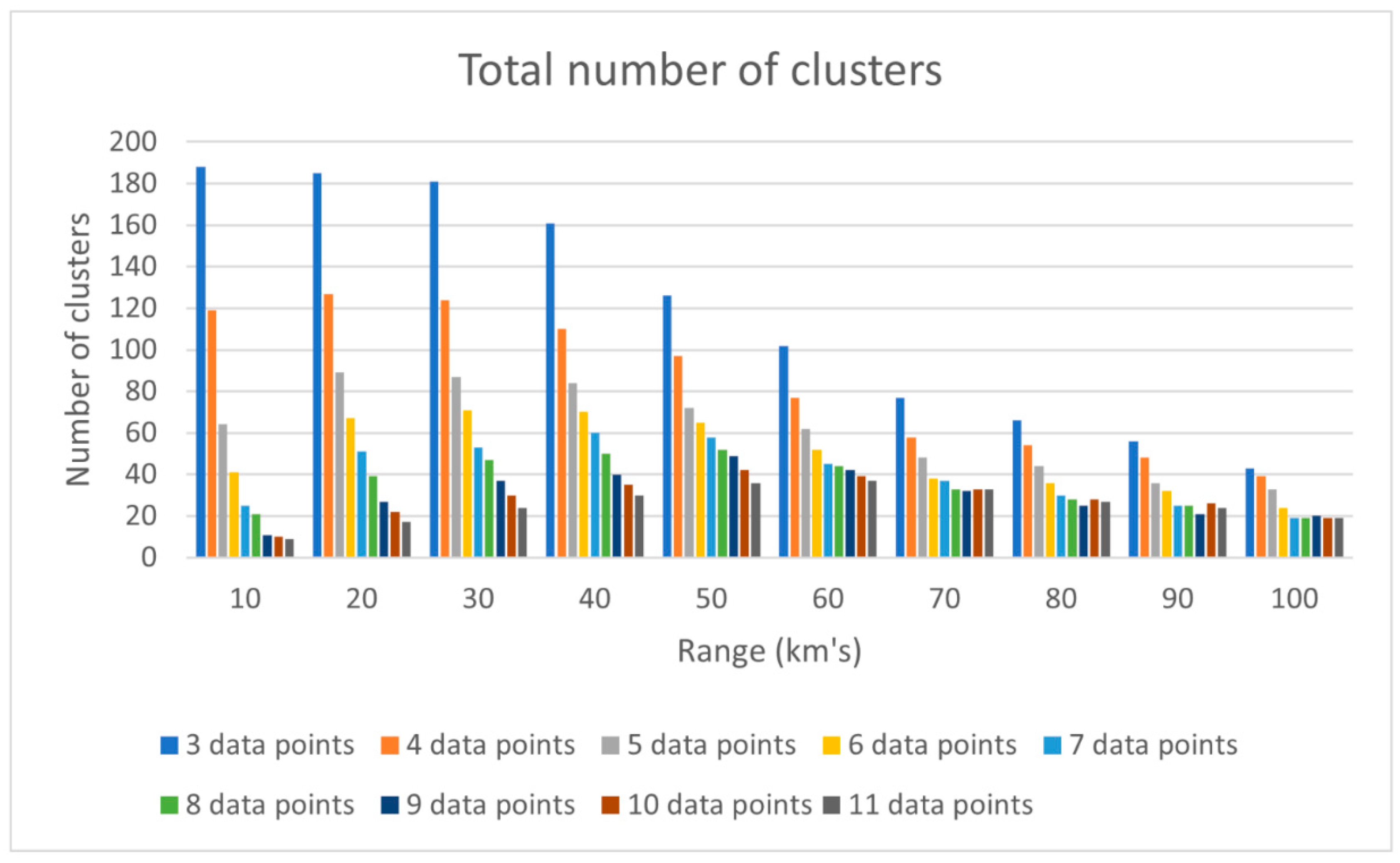
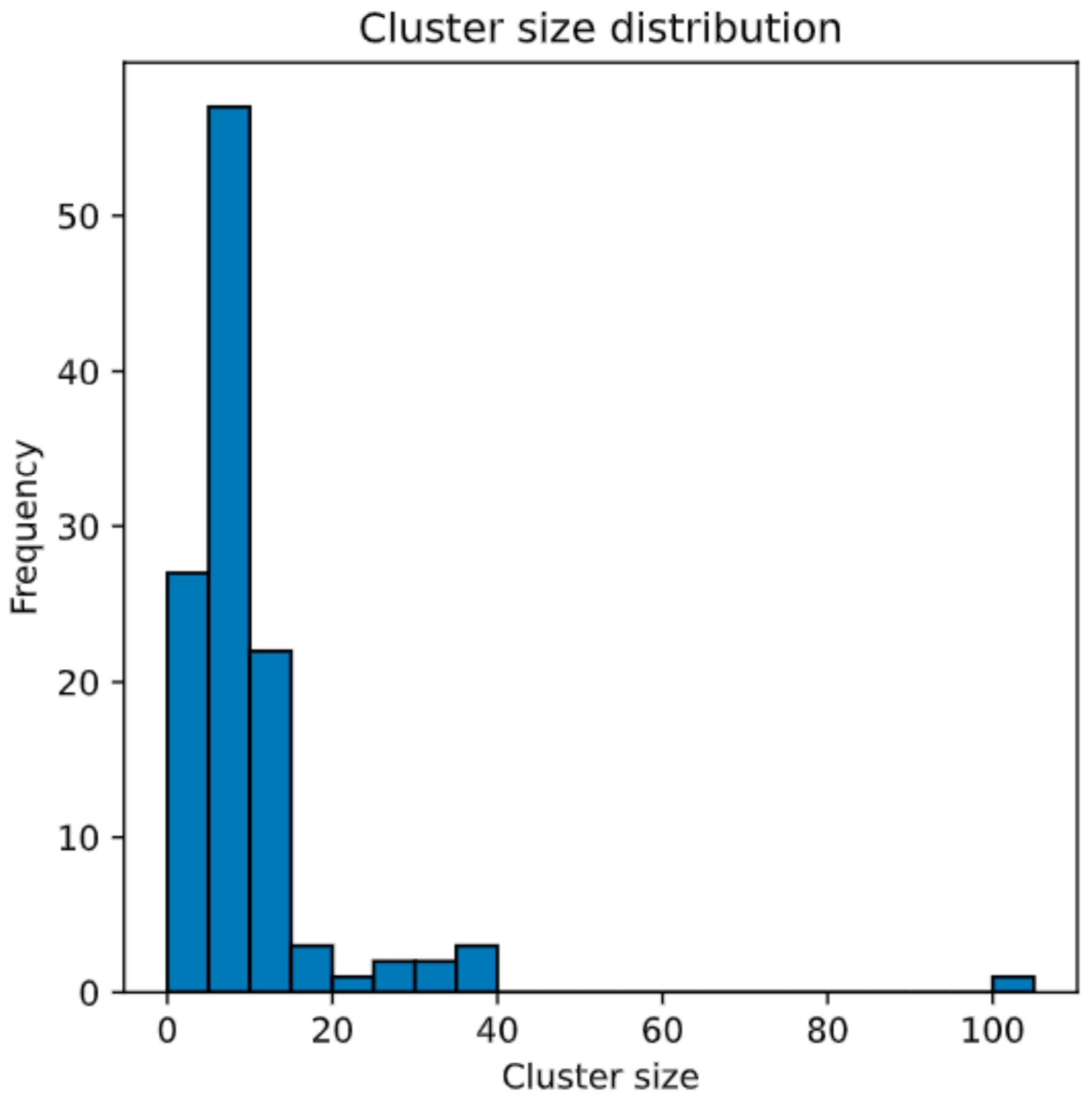
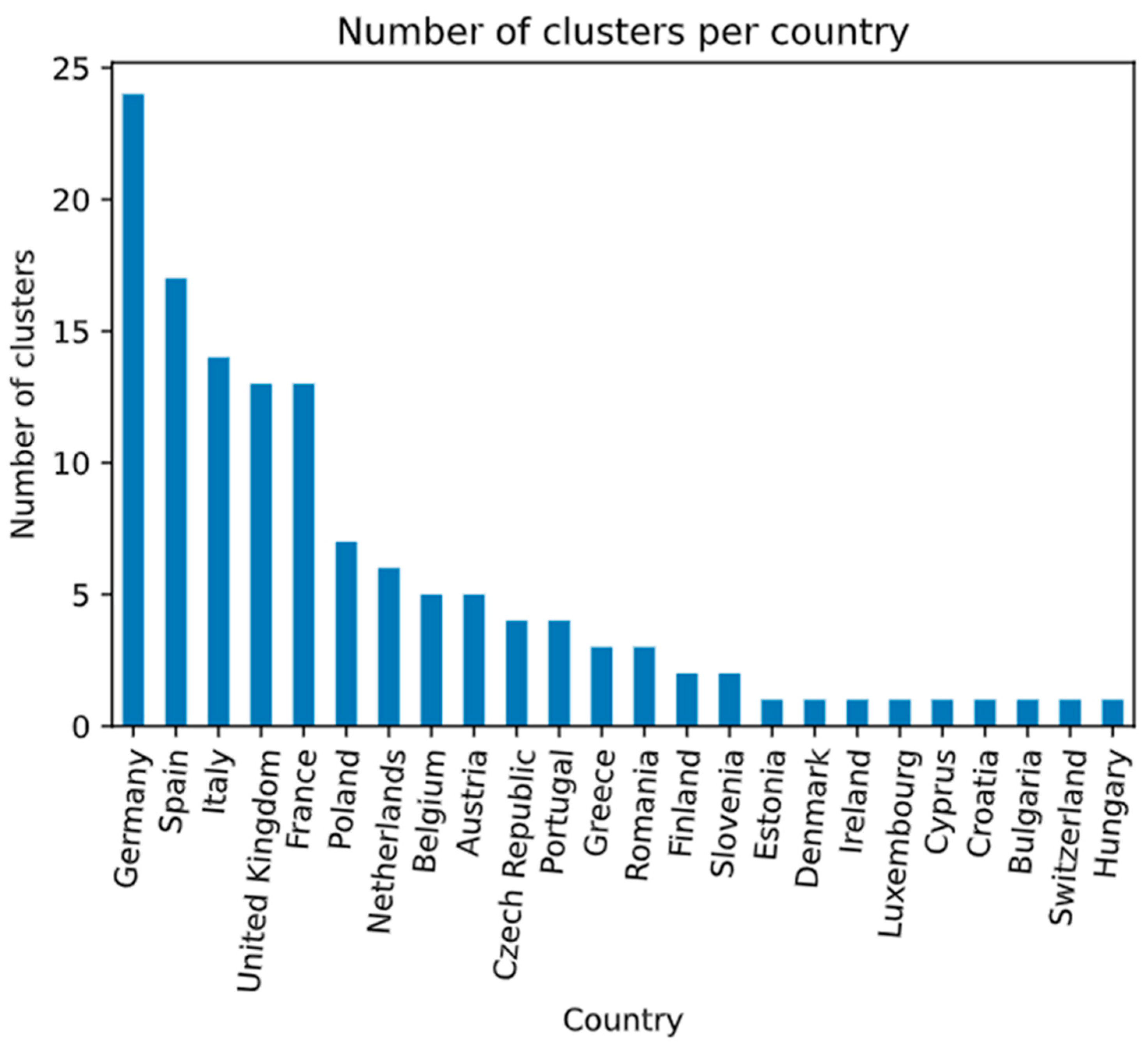
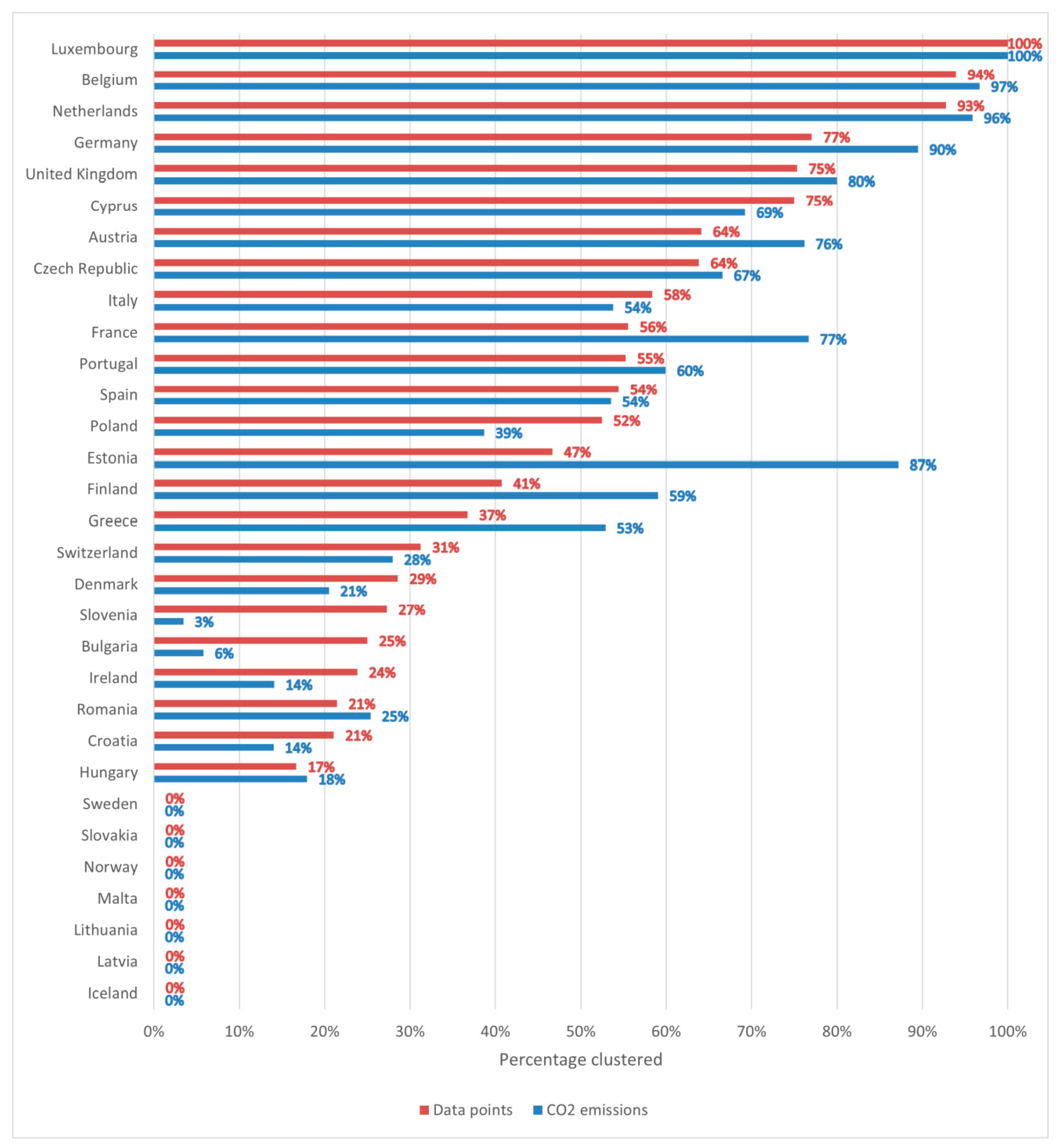
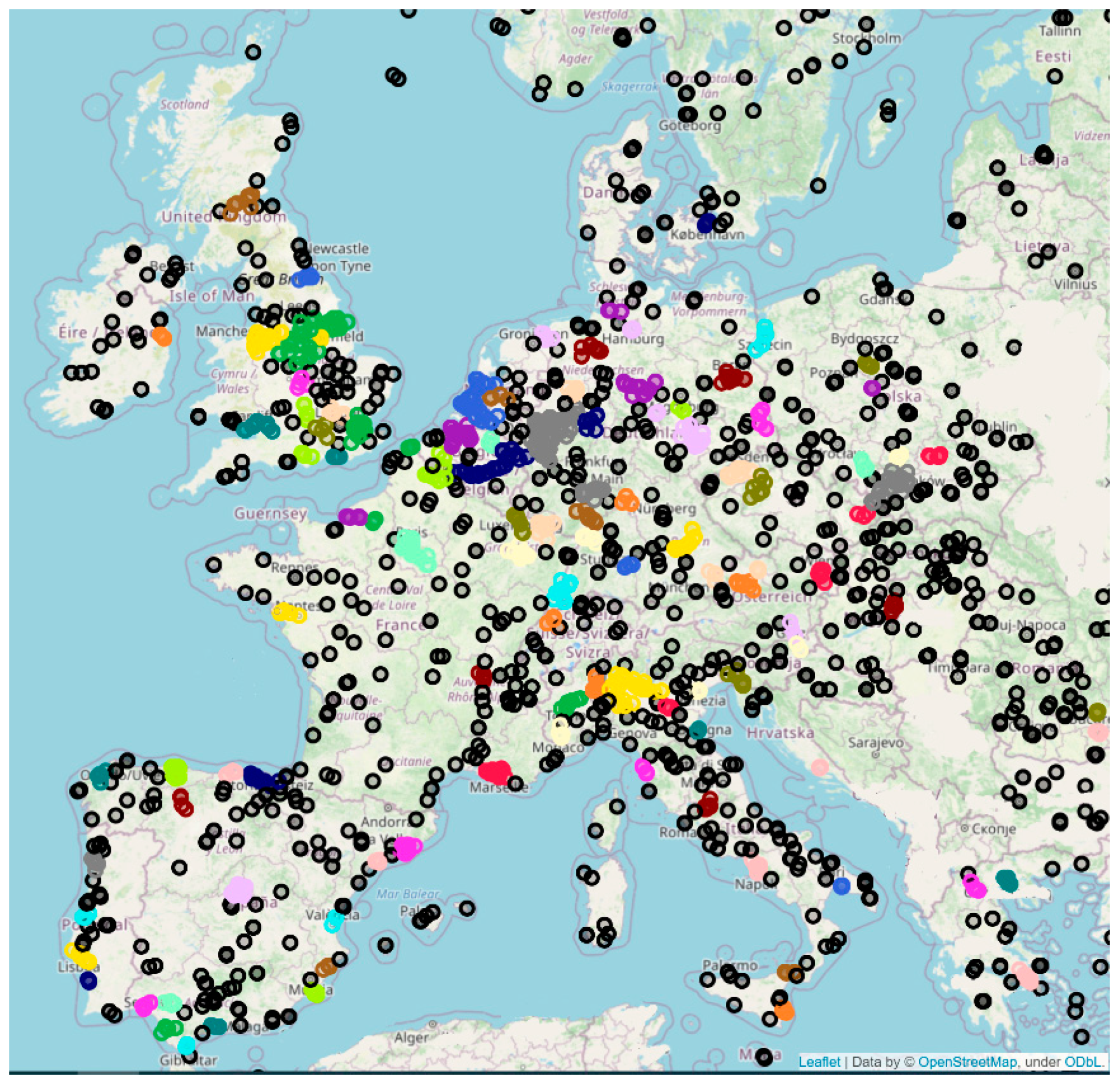

| Clustering Method | Internal Validation (Silhouette Score) | External Validation (Visual Maps) | Relative Validation (Parameter Sensitivity) |
|---|---|---|---|
| K-means | x | x | |
| HAC | x | x | |
| DBSCAN | x | x |
| Industry Type | Amount Clustered | Total | Percentage Clustered |
|---|---|---|---|
| Aluminium production | 21 | 45 | 47% |
| Copper production | 3 | 9 | 33% |
| Extraction of natural gas | 2 | 16 | 13% |
| Lead, zinc and tin production | 5 | 7 | 71% |
| Manufacture of basic iron and steel and of ferro-alloys | 97 | 159 | 61% |
| Manufacture of cement | 165 | 366 | 45% |
| Manufacture of dyes and pigments | 6 | 7 | 86% |
| Manufacture of fertilisers and nitrogen compounds | 15 | 31 | 48% |
| Manufacture of glues | 1 | 1 | 100% |
| Manufacture of industrial gases | 25 | 25 | 100% |
| Manufacture of lime and plaster | 65 | 110 | 59% |
| Manufacture of man-made fibres | 2 | 2 | 100% |
| Manufacture of mortars | 1 | 1 | 100% |
| Manufacture of other ceramic products | 1 | 1 | 100% |
| Manufacture of other chemical products n.e.c. | 4 | 8 | 50% |
| Manufacture of other inorganic basic chemicals | 47 | 65 | 72% |
| Manufacture of other organic basic chemicals | 77 | 99 | 78% |
| Manufacture of plastics in primary forms | 16 | 24 | 67% |
| Manufacture of refined petroleum products | 94 | 130 | 72% |
| Manufacture of synthetic rubber in primary forms | 1 | 2 | 50% |
| Other non-ferrous metal production | 1 | 2 | 50% |
| Precious metals production | 1 | 1 | 100% |
| Production of electricity | 453 | 807 | 56% |
| Country | Number of Cities | Number of Cities Clustered | Percentage Clustered |
|---|---|---|---|
| Belgium | 8 | 6 | 75% |
| Germany | 81 | 57 | 70% |
| Netherlands | 25 | 17 | 68% |
| Cyprus | 3 | 2 | 67% |
| Spain | 61 | 37 | 61% |
| Austria | 5 | 3 | 60% |
| Greece | 10 | 6 | 60% |
| United Kingdom | 96 | 56 | 58% |
| Ireland | 2 | 1 | 50% |
| Slovenia | 2 | 1 | 50% |
| Portugal | 17 | 7 | 41% |
| France | 74 | 30 | 41% |
| Italy | 46 | 16 | 35% |
| Czech Republic | 6 | 2 | 33% |
| Croatia | 4 | 1 | 25% |
| Denmark | 4 | 1 | 25% |
| Poland | 30 | 6 | 20% |
| Switzerland | 10 | 2 | 20% |
| Finland | 6 | 1 | 17% |
| Romania | 24 | 4 | 17% |
| Hungary | 13 | 2 | 15% |
| Bulgaria | 8 | 1 | 13% |
| Estonia | 2 | 0 | 0% |
| Georgia | 1 | 0 | 0% |
| Iceland | 1 | 0 | 0% |
| Latvia | 1 | 0 | 0% |
| Lithuania | 4 | 0 | 0% |
| Luxembourg | 1 | 0 | 0% |
| Malta | 1 | 0 | 0% |
| Norway | 2 | 0 | 0% |
| Slovakia | 5 | 0 | 0% |
| Sweden | 13 | 0 | 0% |
| Ukraine | 1 | 0 | 0% |
| Sector Combination | Number of Potential Synergies | Number of Cross-Sectorial Combinations |
|---|---|---|
| Chemical-District | 8 | 576 |
| Chemical-Steel | 17 | 408 |
| Steel-District | 8 | 408 |
| Chemical-Mineral | 7 | 144 |
| Mineral-District | 2 | 144 |
| Chemical-Cement | 16 | 120 |
| Cement-District | 7 | 120 |
| Steel-Mineral | 6 | 102 |
| Steel-Cement | 15 | 85 |
| Cement-Mineral | 8 | 30 |
Publisher’s Note: MDPI stays neutral with regard to jurisdictional claims in published maps and institutional affiliations. |
© 2021 by the authors. Licensee MDPI, Basel, Switzerland. This article is an open access article distributed under the terms and conditions of the Creative Commons Attribution (CC BY) license (https://creativecommons.org/licenses/by/4.0/).
Share and Cite
Mendez Alva, F.; De Boever, R.; Van Eetvelde, G. Hubs for Circularity: Geo-Based Industrial Clustering towards Urban Symbiosis in Europe. Sustainability 2021, 13, 13906. https://doi.org/10.3390/su132413906
Mendez Alva F, De Boever R, Van Eetvelde G. Hubs for Circularity: Geo-Based Industrial Clustering towards Urban Symbiosis in Europe. Sustainability. 2021; 13(24):13906. https://doi.org/10.3390/su132413906
Chicago/Turabian StyleMendez Alva, Francisco, Rob De Boever, and Greet Van Eetvelde. 2021. "Hubs for Circularity: Geo-Based Industrial Clustering towards Urban Symbiosis in Europe" Sustainability 13, no. 24: 13906. https://doi.org/10.3390/su132413906
APA StyleMendez Alva, F., De Boever, R., & Van Eetvelde, G. (2021). Hubs for Circularity: Geo-Based Industrial Clustering towards Urban Symbiosis in Europe. Sustainability, 13(24), 13906. https://doi.org/10.3390/su132413906





